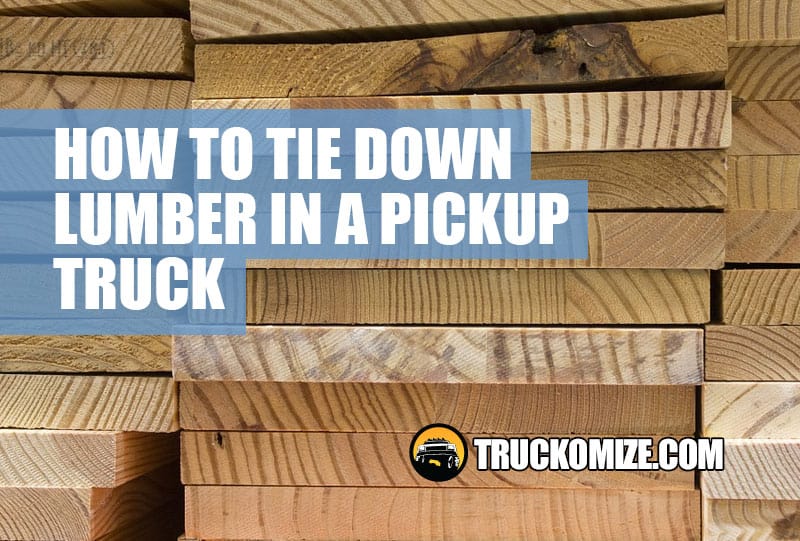Did you know that incorrect loading causes around 100 deaths and is responsible for around 25,000 accidents each year in the USA alone? That statistic is according to the AAA Foundation for Traffic Safety, and it sounds about right.
How often do you see silly accidents just waiting to happen because someone is hauling lumber in an unsafe way?
With that in mind, can you honestly say that you know how to safely and securely load your pickup truck to avoid accidents and injuries? After all, if someone dies, suffers injury or you damage someone else’s property, you – and only you – are liable.
That is a sobering thought!
With that in mind, I thought I would put some notes down here today using what I learned from the couple of times I’ve tied down lumber in my pickup truck.
How to tie down lumber in a pickup truck
- Bundle the lumber load together at both ends with straps.
- Use the right equipment: high load bearing ratchet straps.
- Secure straps to the correct anchor points depending on the size of your load.
- Attach a red flag to the end of your load.
The pickup truck you are driving can contribute to the ease or difficulty of transporting lumber loads.
In most instances, lumber is cut to awkward lengths and this poses certain challenges to the driver when it comes to hauling it from A to B.
There is no need to haul lumber unsafely as you can quickly learn the correct loading techniques. With the right know-how and the correct techniques, there is no reason for tying down lumber to a pickup truck to become overly complicated or physically challenging.
In fact, it can become quite easy – like second nature.
Below I will elaborate on the points mentioned above and provide some tips and helpful advice on tying down lumber to a pickup truck.
Before you tie down the lumber
There is something that you need to consider before you endeavor to haul a heavy load of lumber in your pickup truck; your vehicle.
Many people consider leaving the pickup truck tailgate up when tying down a load.
This can be absolutely fine, but only if the load is under 250lbs. While your pickup truck is designed to carry a load and even take somewhat of a beating, your tailgate is not.
To save your tailgate, open it and lay it flat when transporting loads over 250lbs.
There is another advantage to doing this; the open tailgate lengthens your truck bed and adds to the support (without the tailgate having to handle the bulk or full pressure of the load) which means less sliding and less opportunity for damage and breakage.
Another thing to consider is the total weight of your load. Pickup trucks also have their limitations.
First check to see what your truck’s load bearing capacity is. Overloading it can lead to serious, costly damage.
4 tips for tying down lumber in a pickup truck securely
Here is what you need to know about our 4 tips for tying down lumber in a pickup truck:
1. Bundle the lumber load at both ends with straps
Lumber planks can slide around individually and can wreak havoc on the back of your pickup truck.
The best way to stop lumber sliding and to discourage individual planks from going rogue is to bundle them.
Do not make the mistake of only securing the load in the middle or on one end. Some have tried this and learnt the hard way!
This does not do much to help control how the lumber slides and moves around. In fact, these methods could make matters worse.
To get more control over your load, bundle it at both ends with straps – pull them tight to ensure that the load is actually firmly set in place. Once bundled you can lay one end of the load against the cab with the other end resting on the tailgate area.
2. Use the right equipment: high load-bearing ratchet straps
Do not make the same mistake that many others have made before! Avoid using bungee cord or rope to secure your load. Lumber can be heavy and when it slides, a rope or bungee cord will prove somewhat useless, especially as they tend to fray or snap under pressure.
Ratchet straps are the best possible choice for tying down lumber.
What sort of ratchet straps should you use?
Of course, you cannot simply buy any ratchet straps and expect them to keep your load in place. You need to pay close attention to how the ratchet strapped is rated in terms of:
- Load bearing capacity – this is the rating that determines what sort of weight the ratchet strap can safely hold without giving way. For lumber, it is recommended that you invest in ratchet straps that have a load bearing capacity of at least 1000lbs.
- Breakage strength limit – this is the rating that tells you at what load weight the ratchet will most likely be able to handle, before it breaks. Make sure you do not push the boundary with this limit. For lumber, it is probably a good idea to look more on the higher end of the scale. Ratchet straps with a 3000lb breakage strength limit are the best and most reliable choice.
Choose your ratchet straps with care and always have the nature and weight of your load in mind before making a purchase.
3. Secure the straps to the correct anchor points depending on the size of your load
You do not need to strap every load the same, but if you want to keep it simple, always strap your load as if it is a heavy load and you cannot go wrong.
However, it stands to reason that smaller or lighter loads require fewer straps and a less complicated strapping technique.
Large loads require careful attention and a strategic strapping strategy that simply will not fail the driver or the load he is carrying.
Here are a few tips on how to strap down your load according to the size/weight:
- How to tie down a small lumber load with ratchet straps: secure one of your ratchet straps to one of the anchor points on the rear of your pickup truck’s bed and stretch it across the end of the bundle, while pulling the strap to the opposite end of the bed. Secure it in place by attaching the ratchet to the rear anchor point and tension it. This should be enough to stop a light lumber load from sliding out. Do not use this technique if the load is heavy.
- How to tie down a heavy lumber load with ratchet straps: most heavy loads require the tailgate to be done which could promote sliding, if the load is not properly secured. Start by laying down your first ratchet strap on the tailgate from 1ft behind your rear anchor points. The second strap should be stretched out on the pickup truck’s bed floor, approximately 1ft behind the front anchor points. Having the straps 1ft after the front and back anchor points creates a forward-pulling motion which helps to deter lumber sliding backwards.
- Carefully place the lumber load onto the straps and wrap them around the load: Take the ends of the straps and pull them firmly now towards the anchor points on the opposite side of the pickup truck bed. Make sure that you secure the load by tensioning the ratchet straps. Test the tension and firmness of the strapping by pushing the load from different directions. Little to no movements means you have done it right.
Attach a red flat to the end of your load
This might not seem like one of the ways to tie down your lumber, but it actually is.
The red flag alerts other road users that your lumber is protruding off the back of your pickup truck.
It can also help you and others to judge the distance that the load is from objects and other vehicles.
The red flag is not optional – it is required by law.
If the company you are collecting the lumber from does not provide a red flag for free, you will need to acquire your own before you hit the highway with your pickup truck. You can tie it tightly to the end of your load, or you can use a stapler to secure the flag effectively.
Make sure that the flag is highly visible and not just a scrap of fabric that is hard to see by other road users.
Conclusion
You must be responsible when carrying lumber in your pickup truck.
When looking into effective ways to tie down lumber in pickup truck to prevent sliding, always remember that the size and weight of the load come into play.
It is not just your ratchet straps and strapping technique that are important.
Your anchor points also need to be very strong and reliable. Take the loading of your lumber seriously as negligence can result in serious losses and even death.
Responsible lumber hauling is not just the way of the future – it is something you need to pay close attention to right now.


